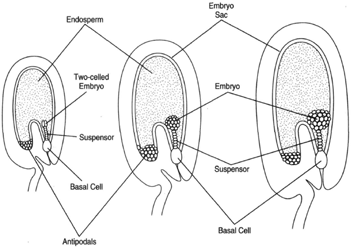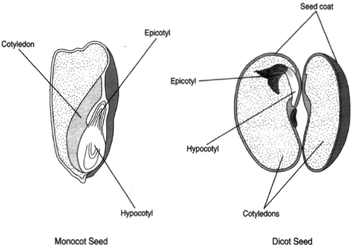Seed Structure and Characteristics
The seed containing the embryo plant also contains endosperm, a food storage tissue. The whole is enclosed in one or two seed coats. Seeds range in size from dust like, such as the seeds of orchids, to a length of one foot or more and a weight of as much as 40 pounds, such as the coconut.The fertilized egg gives rise not only to an embryo plantlet, but also to some extraembryonic cells. In early cell divisions, an embryo portion is distinguishable from a basal cell and the suspensor. The basal cell is at the micropylar end of the ovule. The basal cell and the suspensor are not part of the embryo, although they are derived from the zygote.
There are two kinds of angiosperm seeds: monocotyledonous and dicotyledonous. The cotyledons are the first-formed leaves that are a part of the seed. They often contain a reserve of nutrients. An important character of angiosperm seeds is the endosperm. Recall that the endosperm, being a consequence of triple fusion, is 3N. Although all seeds contain endosperm before they are mature, the endosperm in many kinds of seeds is consumed by the growth of the embryo plantlet during the maturation process. Whereas monocots always have a residuoef endosperm in the mature seed, only some species of dicots exhibit endosperm residue. Squash and castor bean, for example, retain endosperm, whereas the endosperm in lupine (a commonly studied plant) is entirely consumed. There is no significant value to the 3N condition of endosperm. It is simply regarded as an evolutionary event with no special value. The endosperm of gymnosperms is always haploid.
When a seed germinates, the portion extending above the cotyledons is the epicotyl: the portion extending below the cotyledons is the hypocotyl. One may therefore suppose that the epicotyl produces the stem, and the hypocotyl produces the root. This is partially true because the hypocotyl may produce a portion of the stem in addition to producing the root. The part of the hypocotyl that produces the root is called the radicle. The growing point of the embryo plant is called the plumule.
As a seed grows toward maturity, the seed coats continue tog row, covering the outside but never completely enclosing the internal portion. A small hole called the micropyle remains. The micropyle allows the entrance of the pollen tube. Although embryo development continues to progress, it slows and in maturity is essentially suspended. In maturity, the water content is much reduced, and the seed may remain in this dry state and dormant for months or even years.
The student may wish to review the discussion of double fertilization in chapter 28 on angiosperms.
 |
| Figure 36-2 Early embryonic development, showing extraembryonic cells. |
 |
| Figure 36-3 (a) A monocot seed, (e.g. corn). (b) A dicot seed, the cotyledons separated, (e.g. beans). |




